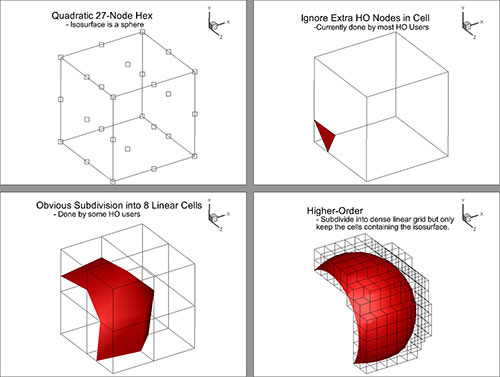Division Technique for Higher-Order Pyramid and Prism Isosurface Visualization
Higher-Order finite-element CFD methods have the potential to reduce the computational cost to achieve a desired solution error. These techniques have been an area of research for many years and are becoming more widely available in popular CFD codes.CFD visualization software is lagging behind the development of higher-order CFD analysis codes.
Visualizing Isosurfaces in Higher-order Element Solutions
In the AIAA SciTech 2020 presentation, I discuss a technique for visualizing isosurfaces in higher-order element solutions with reduced memory usage. The technique recursively subdivides higher-order elements into smaller linear sub-elements. In these sub-elements the isosurface can be extracted using standard marching-tets or marching-cubes techniques. Memory usage is minimized by discarding unneeded sub-elements. In a previous paper this technique was demonstrated with higher-order hexahedra and tetrahedra with Lagrangian polynomial basis functions.
In this paper, the technique is extended to higher-order pyramids and prisms. The results are compared to other techniques for visualization of higher-order element isosurfaces.
Tecplot Blogs on Higher Order Element Solutions
Scott has written a series of blogs on visualization techniques for higher-order elements. You can link directly to the blogs below or view the list.
- A Primer on Visualizing Higher-Order Elements
- Complex Nature of Higher-Order Finite-Element Data
- Isosurface Algorithms for Visualizing Higher Order Elements
- Visualizing Higher-Order Finite-Element Surfaces
Scott’s Presentation
January 15, 2021 from 2:30 PM to 3:45 PM Eastern Time.
Presentation Type: Technical Paper (Completed Research)
Session: MVCE-02, Meshing Applications II
Technical Paper by:
Scott T. Imlay, David E. Taflin, and Craig Mackey
Tecplot Inc., Bellevue, WA, 98006





